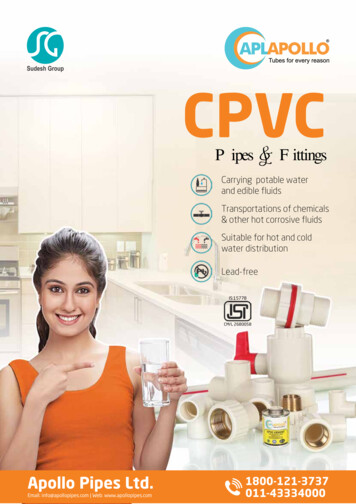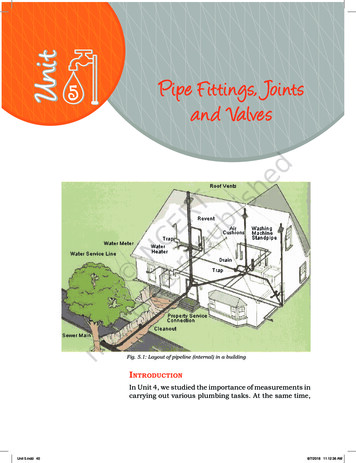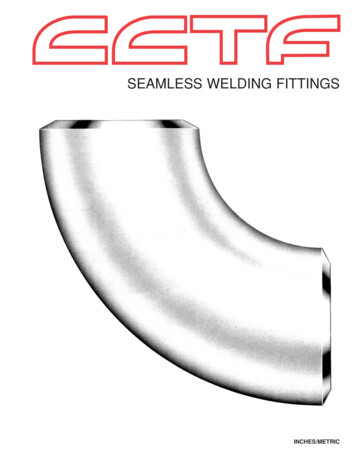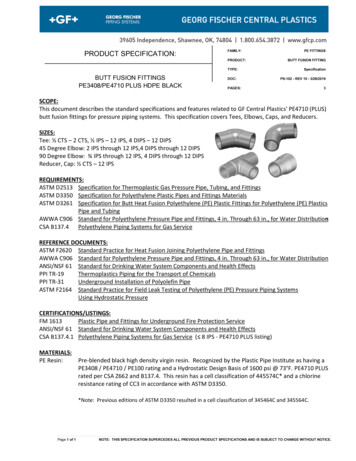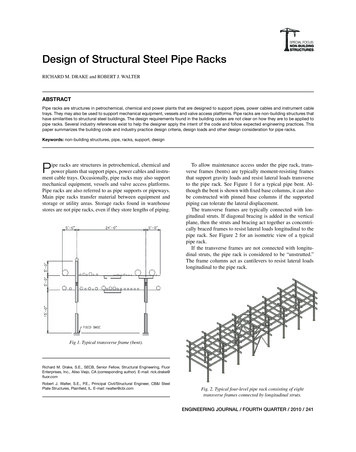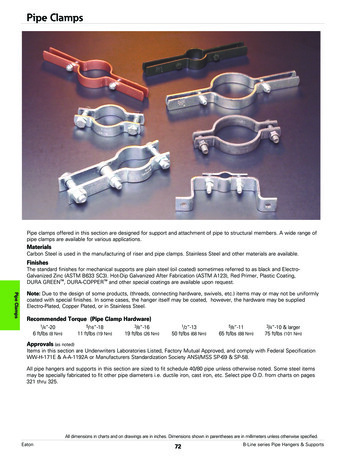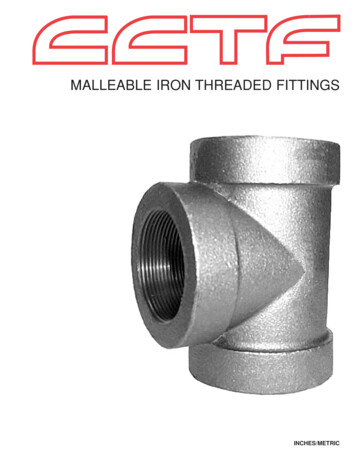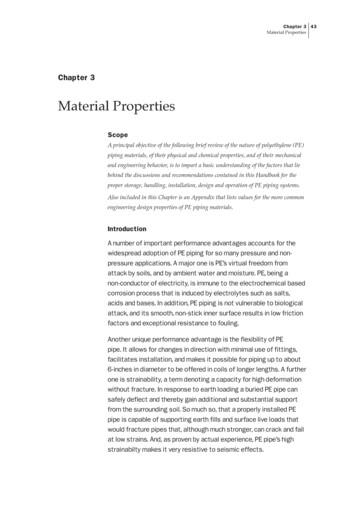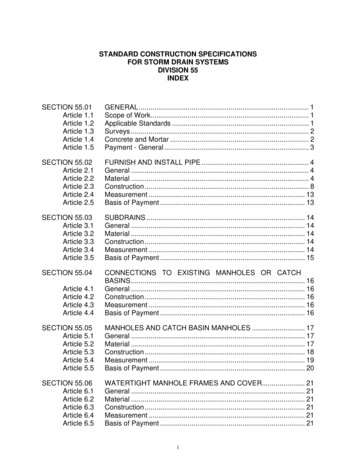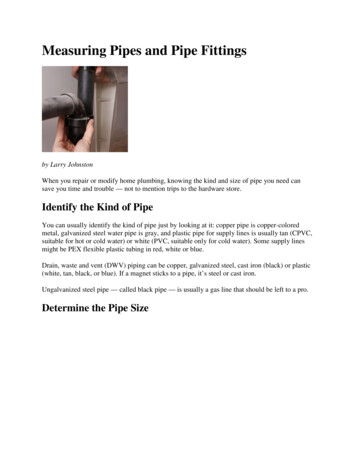
Transcription
Measuring Pipes and Pipe Fittingsby Larry JohnstonWhen you repair or modify home plumbing, knowing the kind and size of pipe you need cansave you time and trouble — not to mention trips to the hardware store.Identify the Kind of PipeYou can usually identify the kind of pipe just by looking at it: copper pipe is copper-coloredmetal, galvanized steel water pipe is gray, and plastic pipe for supply lines is usually tan (CPVC,suitable for hot or cold water) or white (PVC, suitable only for cold water). Some supply linesmight be PEX flexible plastic tubing in red, white or blue.Drain, waste and vent (DWV) piping can be copper, galvanized steel, cast iron (black) or plastic(white, tan, black, or blue). If a magnet sticks to a pipe, it’s steel or cast iron.Ungalvanized steel pipe — called black pipe — is usually a gas line that should be left to a pro.Determine the Pipe Size
Pipe goes by nominal sizes rather than actual measurements, so identifying pipe size can betricky. Copper 3/4-inch pipe, for instance, doesn’t measure 3/4-inch anywhere — its outsidediameter (OD) is 0.875 inch and inner diameter (ID) is 0.811 inch for Type M pipe (adesignation relating to wall thickness). But steel 3/4-inch pipe is 1.050 inch OD and 0.824 inchID for standard Schedule 40 pipe (also a wall thickness designation). Plastic pipe measures thesame as steel pipe.To make things a little more confusing, sizes for tubing, such as the small-diameter plastic orcopper tubing used to hook up icemakers, are the actual outside diameter and hose sizes indicateactual inside diameter.Look for manufacturer’s markings printed on plastic, copper and cast iron pipe to easily identifytype and size. Here’s how to determine pipe size by simply measuring the OD.Copper. The nominal size of copper pipe, whether supply lines or DWV, is always 1/8 inch lessthan the OD measurement. For example, copper pipe that measures 5/8 inch OD, is called 1/2inch pipe. The ID varies because wall thickness varies. Type K has the thickest wall, followed byType L, Type M and DWV.Cast iron. Cast-iron soil pipe in residential DWV systems is usually 3-inch or 4-inch nominalsize. Pipe OD measures about 3/8 inch larger than the nominal size.Plastic and steel. Plastic and steel pipe with the same nominal size have the same OD. ConvertOD measurements to nominal size with the following table.
Fit the FittingsFittings join pipes together. How a fitting connects pipes depends on the type of pipe: Fittings for copper and plastic pipe slip over the end of the pipe and are soldered or gluedin place.Fittings for steel pipe screw onto tapered external threads on the end of the pipe. Thetaper jams the threads together to prevent leaks.Cast-iron pipe may have straight ends that take clamp-on fittings — called hubless pipe— or one straight end and a belled end to fit over another pipe’s straight end — calledhub and spigot pipe.Fittings don’t interchange from one type or size of pipe to another, but you can buy fittings tojoin different types or sizes of pipe. To buy fittings, specify the type of fitting you need and thekind and size of pipe: “I need a 90-degree sweat-solder elbow for ¾ inch copper,” for example.And always buy a few more than you need.Figure the Pipe LengthTo determine the length of pipe needed to connect two fittings, take two dimensions intoaccount: The fitting socket depth and the laying length. The illustration below shows how thedimensions relate to pipe length.Socket depth, also called makeup length, is ,the distance from the face of the fitting to thebottom of the socket. That’s how much pipe goes into the fitting.Laying length, also called fitting gain, is the distance from the bottom of the socket to thecenterline of the intersecting pipe. That’s how much length the fitting adds to the pipe.Measure the laying length on the fittings you’re using (it varies amount fitting styles andmanufacturers). You can then easily figure the pipe length using one of these methods:
Measure the face-to-face distance between the fittings and add twice the socket depth.Measure the center-to-center distance between the two pipes and subtract the total of thelaying lengths of the fittings at both ends.The table below shows the socket depth for threaded steel pipe.Writer Larry Johnston’s 1908 house in Des Moines is a veritable testing lab for home repairskills and techniques. Copyright 2011, Sears Brands, LLC. All Rights Reserved.Have a question? Ask now
PIPE / PIPE THREAD DIMENSIONSNominal Pipe sizes do not match any of its actual physical dimensionsThe OD of pipe / fitting must be measured & compared to the table foridentificationFor example, a 3/4" NPT pipe thread has an outside diameter of 1.050 inchesand 14 threads per inch. Each thread size has a defined number of threads per inch (TPI),but several sizes have the same TPI; because of this, both the TPI and OD of the threadare required for positive identification of thread size.Male threads:Measure the outside diameter of thelarge portion of the thread at "A"; Findfigure nearest this dimension in column1 or 2 of chart. The dimension in column3 will be your nominal pipe thread size.Female Threads:Measure top diameter of thread at "B";Find figure nearest this dimension incolumn 1 or 2 of chart. The dimension incolumn 3 will be your nominal pipe threadsize.Column 1Column 2Column 3Column 4Column 5ODActualPipe SizeTPINormal(only for quick reference )Decimal InchNominalThreads per Inchfor a tight joint(dimension 1-5/16"1.315"1"11-1/20.6828Fraction InchEngagement
81.25004-1/24.500"4"81.3000Two common pipe thread sizes exist, the tapered National Pipe Thread (NPT) and thestraight National Standard Free-Fitting Straight Mechanical Pipe Thread (NPSM).The tapered threads are for joining and sealing, the straight threads are only for joining.Dry-seal thread (NPTF) allows for joining without sealants.Female NPT threads may be designated as "FPT"Male NPT threads may be designated as "MPT."The pipe size is often written such as this 1/8"-27, with a hyphen between size & thread perinch, and pronounced as "one eighth twenty-seven"Three less common threads exist, the Garden Hose Thread (GHT),Fire Hose Coupling (NST) and British Standard Taper Pipe Thread (BSPT).The NPT and NPTF threads are interchangeable with sealants such as PTFE tape.None of the other thread standards are interchangeable.Definition of pipe thread acronymsNPTNational Pipe ThreadFPTFemale (National) Pipe ThreadMPTMale (National) Pipe ThreadPTFSAE short tape pipe threadNPTFAmerican National taper pipe thread for Drysealpressure-tight jointsNPSM American National straight pipe thread for mechanical jointsNPSI American National straight intermediate pipe thread
also called makeup length, is ,the distance from the face of the fitting to the bottom of the socket. That’s how much pipe goes into the fitting. Laying length, also called fitting gain, is the distance from the bottom of the socket to the centerline of the intersecting p
